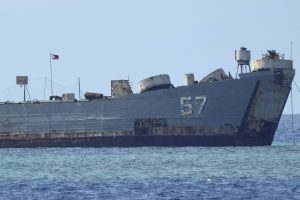Philippine Foreign Secretary Enrique Manalo yesterday called on China to take steps to reduce tensions over clashing claims in the South China Sea, at a time of growing tensions over the Philippine-held Second Thomas Shoal.
During an address to a forum on the maritime region co-organized by the Konrad-Adenauer-Stiftung Philippines and the Foreign Service Institute of the Philippines, Manalo said that the South China Sea claimant states, which also include Taiwan, Vietnam, Brunei, and Malaysia, “must let peace and dialogue prevail,” according to a report by BenarNews.
In particular, Manolo said, the maritime disputes between China and the Philippines, which have flared in recent weeks, demanded “the highest commitment to peace.”
His address focused on the South China Sea as a shared “maritime heartland” that has long been crucial to the peoples of the region, and will continue to be the “key to food and energy security in the region.”
“We must allow the luminous histories of these waters as connectors of our communities to prevail,” he said, as per BenarNews, “even in the face of disputes and serious incidents in the South China Sea, and over the prisms of competition with which the current situation is commonly seen.”
Manolo’s address comes at a time of renewed friction with China in disputed waters. Early this month, the Philippines accused China’s coast guard of blocking and shooting a water cannon at a Philippine navy-chartered supply boat in the vicinity of Second Thomas Shoal. The Chinese intervention was just the latest measure designed to prevent the resupply of the Philippine marines stationed aboard the BRP Sierra Madre, a decrepit World War II-era ship that was intentionally grounded in the shoal’s shallow waters in 1999, in response to China’s occupation of nearby Mischief Reef in 1994.
The Chinese actions prompted strongly worded protests from both the Philippine Coast Guard (PCG) and the Armed Forces of the Philippines (AFP), and the summoning of Chinese ambassador Huang Xilian by the Foreign Ministry. It also elicited strong condemnations from partners and allies of the Philippines, including the United States.
For its own part, the Chinese government has called on Manila to remove the Sierra Madre from Second Thomas Shoal, which is known to Manila as Ayungin Shoal and to Beijing as Ren’ai Jiao. During a press conference in Quezon City on August 14, Zhou Zhiyong, deputy chief of mission of the Chinese Embassy in Manila, said that the Philippines had breached an earlier understanding that it not transport construction materials to the Sierra Madre. Zhou said that the agreement was reached at the end of 2021 following “several rounds of discussions in order to manage the disputes.”
Philippine officials have remained defiant, pledging to carry out another resupply mission within two weeks. The AFP also said last week that it was considering following the example of Vietnam and China and deploying its own maritime militia to defend its sovereignty in what it terms the West Philippine Sea.
The incident highlighted the dilemma facing the Philippines at Second Thomas Shoal, which has been the subject of what amounts to an informal Chinese blockade. In February, the PCG accused a Chinese coast guard ship of hitting a Philippine coast guard vessel with a military-grade laser in a successful attempt to prevent it from approaching the shoal.
China’s campaign has put the Philippines in a tricky position. The government is currently taking an approach of publicizing Chinese transgressions in the hope of mobilizing international support for its position, and there are certainly more legal avenues that it could pursue. But any more muscular attempt to resupply the ship, perhaps with support from the United States or other partners, runs the risk of prompting an escalation, and as Euan Graham of the Australia Strategic Policy Institute wrote on August 14, of “subjecting the Philippines to the risk that China will seize the opportunity, as it did at Scarborough Shoal in 2012, of militarizing its blockade.”
Complicating the situation further is the fact that the Sierra Madre is in an advanced state of decay. This week, a U.S. analyst told Australia’s ABC News that it was only a matter of time before the vessel “succumbs to the elements.” The fragility of the structure also poses a challenge to resupplying the ship’s inhabitants by helicopter.
If and when the ship disintegrates, it remains unclear what the Philippines could do to maintain its foothold on the shoal. With the Sierra Madre unlikely to last forever, Graham wrote, “China’s increasingly heavy-handed tactics are asking a fundamental question. In this context, Manila needs to swallow hard and accept some calculated risks.”

































